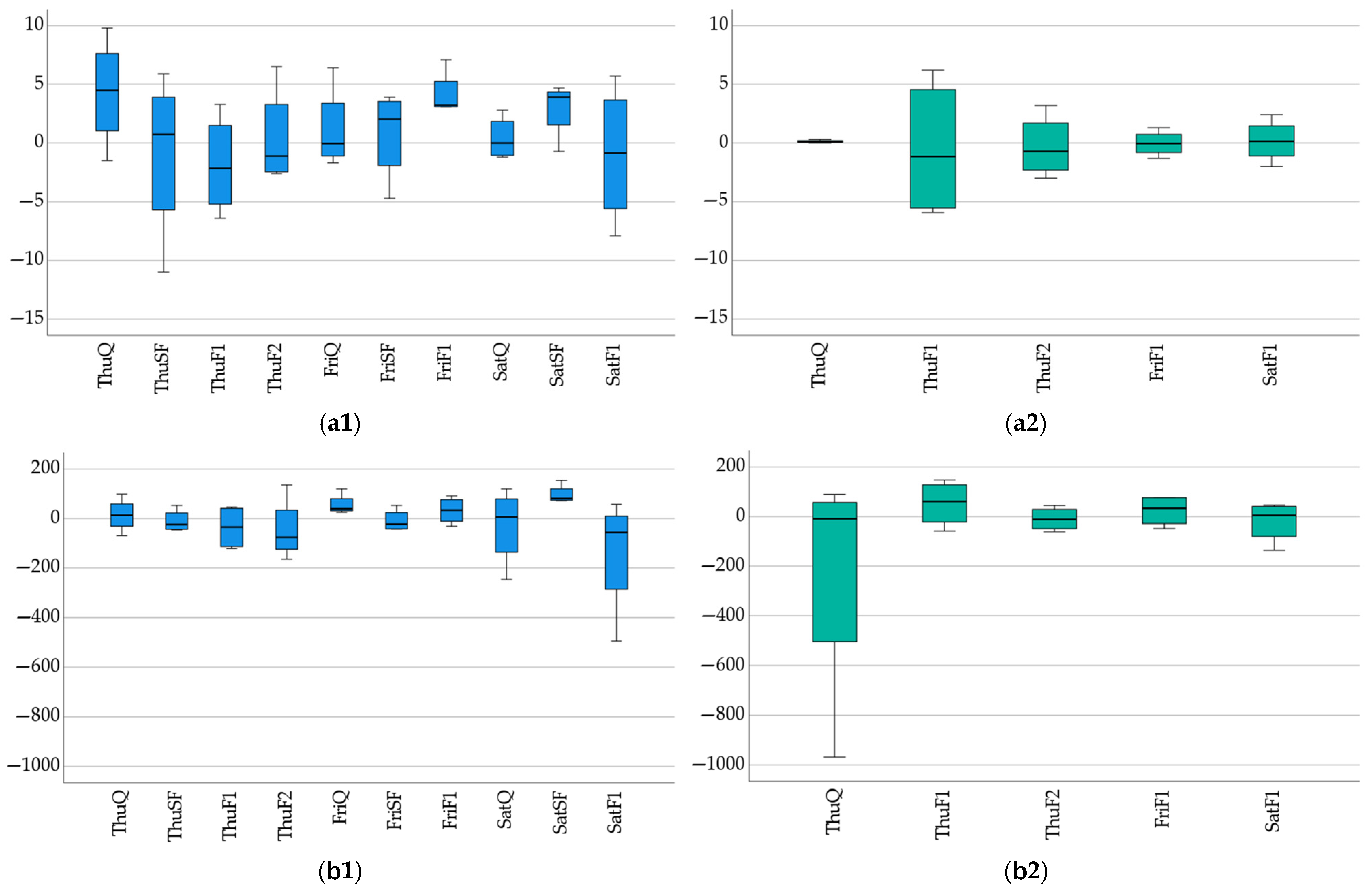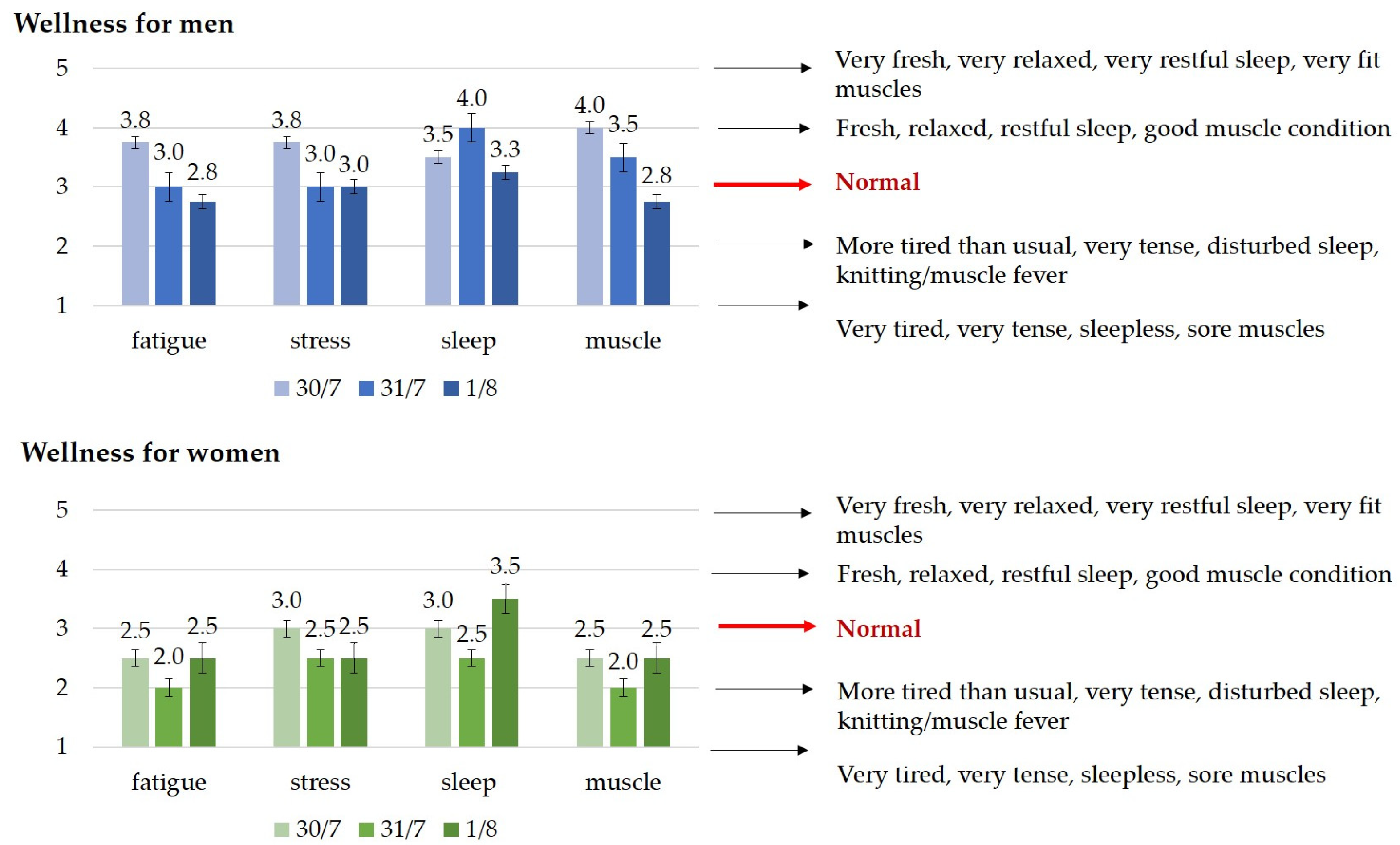A Pilot Study of the Effect of Locomotor and Mechanical Loads on Elite Rowers During Competition Days
Abstract
1. Introduction
2. Materials and Methods
Statistical Analysis
3. Results
4. Discussion
4.1. Recommendations
4.2. Limitations and Strengths
5. Conclusions
Author Contributions
Funding
Institutional Review Board Statement
Informed Consent Statement
Data Availability Statement
Acknowledgments
Conflicts of Interest
References
- Caspersen, C.J.; Powell, K.E.; Christenson, G. Physical Activity, Exercise, and Physical Fitness: Definitions and Distinctions for Health-Related Research. Public Health Rep. 1985, 100, 126–131. [Google Scholar]
- Martinez, M.; Kim, J.; Shah, A.; Phelan, D.; Emery, M.; Wasfy, M.; Fernandez, A.; Bunch, T.; Dean, P.; Danielian, A.; et al. Exercise-Induced Cardiovascular Adaptations and Approach to Exercise and Cardiovascular Disease: JACC State-of-the-Art Review. J. Am. Coll. Cardiol. 2021, 78, 1453–1470. [Google Scholar] [CrossRef] [PubMed]
- Mäestu, J.; Jürimäe, J.; Jürimäe, T. Monitoring of Performance and Training in Rowing. Sports Med. 2005, 35, 597–617. [Google Scholar] [CrossRef]
- Soper, C.; Hume, P. Towards an Ideal Rowing Technique for Performance. Sports Med. 2004, 34, 825–848. [Google Scholar] [CrossRef]
- Herrebrøden, H.; Espeseth, T.; Bishop, L. Mental effort in elite and non-elite ranks. J. Sport Exerc. Psychol. 2023, 45, 208–223. [Google Scholar] [CrossRef]
- Santamaria, L.J.; Webster, K.E. The effect of fatigue on lower-limb biomechanics during single-limb landings: A systematic review. J. Orthop. Sports Phys. Ther. 2010, 40, 464–473. [Google Scholar] [CrossRef]
- Borresen, J.; Lambert, M.I. Changes in heart rate recovery in response to acute changes in training load. Eur. J. Appl. Physiol. 2007, 101, 503–511. [Google Scholar] [CrossRef]
- Davis, J.M. Central and peripheral factors in fatigue. J. Sports Sci. 1995, 13 (Supppl. 1), S49–S53. [Google Scholar] [CrossRef] [PubMed]
- Latash, M.L.; Danion, F.; Bonnard, M. Effects of transcranial magnetic stimulation on muscle activation patterns and joint kinematics within a two-joint motor synergy. Brain Res. 2003, 961, 229–242. [Google Scholar] [CrossRef] [PubMed]
- Florian Husmann, Martin Gube, Sabine Felser, Matthias Weippert, Anett Mau-Moeller, Sven Bruhn, and Martin Behrens Central Factors Contribute to Knee Extensor Strength Loss after 2000-m Rowing in Elite Male and Female Rowers. Med. Sci. Sports Exerc. 2017, 19, 440–449. [CrossRef]
- Gathercole, R.; Sporer, B.; Stellingwerff, T.; Sleivert, G. Alternative Countermovement-Jump Analysis to Quantify Acute Neuromuscular Fatigue. Int. J. Sports Physiol. Perform. 2015, 10, 84–92. [Google Scholar] [CrossRef]
- Schiphof-Godart, L.; Roelands, B.; Hettinga, F.J. Drive in sports: How mental fatigue affects endurance performance. Front. Psychol. 2018, 9, 1383. [Google Scholar] [CrossRef]
- Russell, S.; Jenkins, D.; Rynne, S.; Halson, S.; Kelly, V. What is mental fatigue in elite sports? Perceptions from athletes and staff. Eur. J. Sport Sci. 2019, 19, 1367–1376. [Google Scholar] [CrossRef]
- Russell, S.; Halson, S.; Jenkins, D.; Rynne, S.; Roelands, B.; Kelly, V. Thinking About Elite Performance: The Experience and Impact of Mental Fatigue in Elite Sport Coaching. Int. J. Sports Physiol. Perform. 2023, 18, 878–884. [Google Scholar] [CrossRef]
- Sun, H.; Soh, K.; Roslan, S.; Wazir, M.; Soh, K. Does mental fatigue affect skilled performance in athletes? A systematic review. PLoS ONE 2021, 16, e0258307. [Google Scholar]
- Marcora, S.M.; Staiano, W.; Manning, V. Mental fatigue impairs physical performance in humans. J. Appl. Physiol. 2009, 106, 857–864. [Google Scholar] [CrossRef]
- Van Cutsem, J.; Marcora, S.; Det Pauw, K.; Bailey, S.; Meeusen, R.; Roelands, B. The effects of mental fatigue on physical performance: A systematic review. Sports Med. 2017, 47, 1569–1588. [Google Scholar] [CrossRef]
- Meeusen, R.; Duclos, M.; Foster, C.; Fry, A.; Gleeson, M.; Nieman, D.; Raglin, J.; Rietjens, G.; Steinacker, J.; Urhausen, A. Prevention, diagnosis and treatment of the overtraining syndrome. Eur. J. Sport Sci. 2013, 13, 1–24. [Google Scholar] [CrossRef]
- Barnes, P.R.; Taylor, D.J.; Kemp, G.J.; Radda, G.K. Skeletal muscle bioenergetics in the chronic fatigue syndrome. J. Neurol. Neurosurg. Psychiatry 1993, 56, 679–683. [Google Scholar] [CrossRef][Green Version]
- Halson, S.L. Monitoring training load to understand fatigue in athletes. Sports Med. 2014, 44 (Suppl. S2), 139–147. [Google Scholar] [CrossRef]
- Garrett, J.; Graham, S.R.; Eston, R.G.; Burgess, D.J.; Garrett, L.J.; Jakeman, J.; Norton, K. A Novel Method of Assessment for Monitoring Neuromuscular Fatigue in Australian Rules Football Players. Int. J. Sports Physiol. Perform. 2019, 14, 598–605. [Google Scholar] [CrossRef]
- Gathercole, R.; Sporer, B.; Stellingwerff, Y.; Sleivert, G.G. Comparison of the Capacity of Different Jump and Sprint Field Tests to Detect Neuromuscular Fatigue. J. Strength Cond. Res. 2015, 29, 2522–2531. [Google Scholar] [CrossRef]
- McLean, B.D.; Coutts, A.J.; Kelly, V.; McGuigan, M.R.; Cormack, S.J. Neuromuscular Endocrine, and Perceptual Fatigue Responses during Different Length between-Match Microcycles in Professional Rugby League Players. Int. J. Sports Physiol. Perform. 2010, 5, 367–383. [Google Scholar] [CrossRef]
- Fitton, J.; Lechat, B.; Reynolds, A.C.; Toson, B.; Manners, J.; Nguyen, P.; Loffler, K.A.; Altree, T.J.; Catcheside, P.; Eckert, D.J. An investigation into sleep, perceived experiences, and exercise performance in elite male cyclists during the Tour de France. Physiol. Rep. 2025, 13, e70395. [Google Scholar] [CrossRef]
- Fullagar, H.H.K.; Vincent, G.E.; McCullough, M.; Halson, S.; Fowler, P. Sleep and sport performance. J. Clin. Neurophysiol. 2023, 40, 408–416. [Google Scholar] [CrossRef]
- Fullagar, H.H.; Skorski, S.; Duffield, R.; Julian, R.; Bartlett, J.; Meyer, T. Impaired sleep and recovery after night matches in elite football players. J. Sports Sci. 2016, 34, 1333–1339. [Google Scholar] [CrossRef]
- Lastella, M.; Roach, G.D.; Halson, S.; Martin, D.; West, N.P.; Sargent, C. The impact of a simulated grand tour on sleep, mood, and well-being of competitive cyclists. J. Sports Med. Phys. Fit. 2015, 55, 1555–1564. [Google Scholar]
- Gorostiaga, E.M.; Granados, C.; Ibáñez, J.; González-Badillo, J.J.; Izquierdo, M. Effects of an entire season on physical fitness changes in elite male handball players. Med. Sci. Sports Exerc. 2006, 38, 357–366. [Google Scholar] [CrossRef]
- Fitts, P.M. Perceptual-Motor Skills Learning. In Categories of Human Learning; Melton, A.W., Ed.; Academic Press: New York, NY, USA, 2004; pp. 243–285. [Google Scholar]
- Wilson, J.R.; Mancini, D.M.; Simson, M. Detection of skeletal muscle fatigue in patients with heart failure using electromyography. Am. J. Cardiol. 1992, 70, 488–493. [Google Scholar] [CrossRef]
- Margaritis, F.; Tessier, E.; Prou, P.; Marconnet, J.-F. Marini Effects of Endurance Training on Skeletal Muscle Oxidative Ca-pacities with and without Selenium Supplementation. J. Trace Elem. Med. Biol. 1997, 11, 37–43. [Google Scholar] [CrossRef]





| First Day | Second Day | Third Day | Total | ||||
|---|---|---|---|---|---|---|---|
| Sex | Morning | Afternoon | Morning | Afternoon | Morning | Afternoon | |
| 2 | ns8+ | ns8+ | ns2- | ni8+ | 4 | ||
| 2 | ns8+ | ns8+ | ni4- | ni8+ | 4 | ||
| 2 | ns8+/ns4x | ns8+/ns4x | ni4- | ni8+ | 6 | ||
| 1 | fs4x/fs8+ | fs4x/fs8+ | fs1x | fs1x | fs4+ | fs2x (2) | 9 |
| 1 | fs4x/fs8+ | fs4x/fs8+ | fs1x | fs1x | fs4+ | fs2x (2) | 9 |
| 2 | ns8+ | ns8+ | nf2- | ni4-/nf2- | ni8+ | 6 | |
| 2 | ns8+ | ns8+ | nf2- | ni4-/nf2- | ni8+ | 6 | |
| 1 | fs4x/fs8+ | fs4x/fs8+ | fs2- | fs2- | fs4+ | fs2x (2) | 9 |
| 1 | fs4x/fs8+ | fs4x/fs8+ | fs2- | fs2- | fs4+ | fs2x (2) | 9 |
| Mean Rank | χ2 | p | Post Hoc | Day 1 | Day 2 | Day 3 | |||||||||
|---|---|---|---|---|---|---|---|---|---|---|---|---|---|---|---|
| Day 1 | Day 2 | Day 3 | M | SD | Mdn | M | SD | Mdn | M | SD | Mdn | ||||
| HRavg | 2.4 | 2.2 | 1.3 | 6.222 | 0.045 | 1 > 3, 1 = 2, 2 = 3 | 130.1 | 4.2 | 128.5 | 130.1 | 4.2 | 129.0 | 130.1 | 4.2 | 116.0 |
| HRmax | 1.8 | 2.2 | 2.0 | 0.941 | 0.625 | 194.6 | 5.6 | 196.0 | 197.6 | 5.8 | 198.0 | 197.9 | 9.3 | 198.0 | |
| IZ1 | 2.2 | 1.7 | 2.1 | 1.556 | 0.459 | 0:56:18 | 0:07:22 | 0:55:55 | 0:41:48 | 0:16:26 | 0:39:46 | 1:16:56 | 0:54:13 | 0:49:33 | |
| IZ2 | 2.8 | 1.3 | 1.9 | 9.556 | 0.008 | 1 > 2, 1 = 3, 2 = 3 | 0:47:28 | 0:11:53 | 0:52:55 | 0:33:05 | 0:09:47 | 0:31:08 | 0:46:01 | 0:39:24 | 0:32:41 |
| IZ3 | 2.4 | 2.1 | 1.4 | 4.667 | 0.097 | 0:18:29 | 0:06:53 | 0:17:15 | 0:13:43 | 0:07:40 | 0:14:47 | 0:10:31 | 0:10:32 | 0:06:53 | |
| IZ4 | 2.1 | 1.9 | 2.0 | 0.222 | 0.895 | 0:08:37 | 0:05:41 | 0:05:55 | 0:07:14 | 0:04:25 | 0:06:16 | 0:08:17 | 0:03:42 | 0:06:44 | |
| IZ5 | 2.4 | 1.8 | 1.8 | 2.667 | 0.264 | 0:07:24 | 0:04:00 | 0:08:02 | 0:06:14 | 0:03:43 | 0:07:04 | 0:06:35 | 0:05:04 | 0:06:55 | |
| TD | 2.2 | 1.6 | 2.2 | 2.667 | 0.264 | 2575.2 | 635.2 | 2441.0 | 2121.6 | 851.5 | 2001.0 | 3752.6 | 2705.6 | 2176.0 | |
| TL | 2.4 | 2.0 | 1.6 | 3.556 | 0.169 | 114.6 | 23.3 | 110.5 | 89.4 | 37.1 | 74.0 | 96.9 | 83.3 | 61.0 | |
| RT | 2.4 | 1.8 | 1.8 | 2.667 | 0.264 | 15.3 | 6.8 | 13.4 | 11.2 | 6.0 | 10.0 | 15.9 | 18.6 | 8.5 | |
| EC | 2.3 | 1.2 | 2.4 | 8.222 | 0.016 | 1 = 3 > 2 | 1151.9 | 87.9 | 1126.5 | 934.3 | 238.0 | 892.0 | 1587.0 | 843.6 | 1078.0 |
Disclaimer/Publisher’s Note: The statements, opinions and data contained in all publications are solely those of the individual author(s) and contributor(s) and not of MDPI and/or the editor(s). MDPI and/or the editor(s) disclaim responsibility for any injury to people or property resulting from any ideas, methods, instructions or products referred to in the content. |
© 2025 by the authors. Licensee MDPI, Basel, Switzerland. This article is an open access article distributed under the terms and conditions of the Creative Commons Attribution (CC BY) license (https://creativecommons.org/licenses/by/4.0/).
Share and Cite
Ihász, F.; Takács, J.; Alföldi, Z.; Kósa, L.; Podstawski, R.; Ferraz, A.; Hinca, B.; Barthalos, I.; Katona, Z.B. A Pilot Study of the Effect of Locomotor and Mechanical Loads on Elite Rowers During Competition Days. Sports 2025, 13, 254. https://doi.org/10.3390/sports13080254
Ihász F, Takács J, Alföldi Z, Kósa L, Podstawski R, Ferraz A, Hinca B, Barthalos I, Katona ZB. A Pilot Study of the Effect of Locomotor and Mechanical Loads on Elite Rowers During Competition Days. Sports. 2025; 13(8):254. https://doi.org/10.3390/sports13080254
Chicago/Turabian StyleIhász, Ferenc, Johanna Takács, Zoltán Alföldi, Lili Kósa, Robert Podstawski, Antonio Ferraz, Bożena Hinca, István Barthalos, and Zsolt Bálint Katona. 2025. "A Pilot Study of the Effect of Locomotor and Mechanical Loads on Elite Rowers During Competition Days" Sports 13, no. 8: 254. https://doi.org/10.3390/sports13080254
APA StyleIhász, F., Takács, J., Alföldi, Z., Kósa, L., Podstawski, R., Ferraz, A., Hinca, B., Barthalos, I., & Katona, Z. B. (2025). A Pilot Study of the Effect of Locomotor and Mechanical Loads on Elite Rowers During Competition Days. Sports, 13(8), 254. https://doi.org/10.3390/sports13080254








